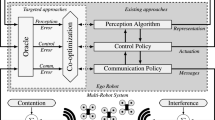Abstract
In this paper, we propose a new TDMA-based MAC protocol which aims at maximizing data transmission parallelism with two channels. The proposed protocol includes two key schemes, a channel allocation scheme and a slot allocation scheme. Each node determines a sending channel and a receiving channel by using the channel allocation scheme and a sending slot and a receiving slot by using the slot allocation scheme. The crux of these schemes lies in that they are performed in a distributed manner such that any two nodes two-hop away vertically are assigned different channels and same slot, and any two nodes four-hop away vertically are assigned the same channel and slot. The protocol structure consists of control transmission period for sending control messages to some specified nodes and data transmission period for periodic data acquisition from all nodes, thus allowing bidirectional communication for industry monitoring and control networks. According to the performance evaluation, the proposed protocol improved data throughput greatly and thus shortened data acquisition time significantly. In consequence, we expect that our protocol will satisfy the tighter time constraints for various real-time applications.













Similar content being viewed by others
References
Singh, B. K., & Tepe, K. E. Feedback based real-time MAC (RT-MAC) protocol for wireless sensor networks. Proceedings of IEEE global telecommunications conference, 1–6.
Wen-Zhan, S., Renjie, H., Shirazi, B., & LaHusen, R. (2009). TreeMAC: Localized TDMA MAC protocol for real-time high-data-rate sensor networks. Proceedings of international conference on pervasive computing and communications, 9–13.
Chen, X., Hu, X., & Zhu, J. (2005). Minimum data aggregation time problem in wireless sensor networks. Proceedings of the first international conference on mobile ad hoc and sensor networks, 133–142.
Yu, B., Li, J., & Li, Y. (2009). Distributed data aggregation scheduling in wireless sensor networks. Proceedings of INFOCOM, 2159–2167.
Malhotra, B., Nikolaidis, I., & Nascimento, M. A. (2011). Aggregation convergecast scheduling in wireless sensor networks. Wireless Network, 17(2), 319–335.
Yafeng, W., Stankovic, J. A., Tian, H., & Shan, L. (2008). Realistic and efficient multi-channel communications in wireless sensor networks. Proceedings of IEEE conference on computer communications, 13–18.
Jovanovic, M. D., & Djordjevic, G. L. (2007). TFMAC: Multi-channel MAC protocol for wireless sensor networks. Proceedings of international conference on telecommunications in modern satellite, cable and broadcasting services, 23–26. doi:10.1109/TELSKS.2007.4375929.
Petersen, S., & Carlsen, S. (2011). WirelessHART versus ISA100.11a: The format war hits the factory floor. IEEE Industrial Electronics Magazine, 5(4), 23–34.
Suriyachai, P., Brown, J., & Roedig, U. (2010). Time-critical data delivery in wireless sensor networks. Proceedings of the 6th IEEE international conference on distributed computing in sensor systems, 216–229.
Le, C., Baihai, Z., Lingguo, C., Qiao, L., & Zhuang, M. (2012). Tree-based delay guaranteed and energy efficient MAC protocol for wireless sensor networks. Proceedings of international conference on industrial control and electronics engineering (ICICEE), 893–897.
Arifuzzaman, M., Matsumoto, M., & Sato, T. (2013). An intelligent hybrid MAC with traffic-differentiation-based QoS for wireless sensor networks. IEEE Sensors Journal, 13(6), 2391–2399.
Oh, H., & Vinh, P. V. (2013). Design and implementation of a MAC protocol for timely and reliable delivery of command and data in dynamic wireless sensor networks. Sensors, 13(10), 13228–13257.
Ye, W., Heidemann, J., & Estrin, D. (2004). Medium access control with coordinated adaptive sleeping for wireless sensor networks. IEEE/ACM Transaction on Networking, 12(3), 493–506.
Yang, D., Xu, Y., & Gidlund, M. (2011). Wireless coexistence between IEEE 802.11- and IEEE 802.15.4-based networks: A survey. International Journal of Distributed Sensor Networks, 2011, 17–30.
Elson, J., Girod, L., & Estrin, D. (2003). Fine-grained network time synchronization using reference broadcasts. Proceedings of the fifth Symposium operating system design and implementation conference, 2860–2864.
Maroti, M., Kusy, B., Simon, G., & Ledeczi, A. (2004). The flooding time synchronization protocol. Proceedings of the 2nd international conference on embedded networked sensor systems, 39–49.
Greunen, J. v., et al. (2003). Lightweight time synchronization for wireless networks. Proceedings of the 2nd ACM international conference on wireless sensor networks and applications, 11–19.
Levis, K. S. A. P. (2006). RSSI is under appreciated. Proceedings of the third workshop on embedded networked sensors, 239–242.
Zhu, J., & Zhao, H. (2009). A link quality evaluation model in wireless sensor networks. Proceedings of the third international conference on sensor technologies and applications, 1–5.
Boano, C.A., et al. (2010). The triangle metric: Fast link quality estimation for mobile wireless sensor networks. Proceedings of the 19th international conference on computer communications and networks (ICCCN), 1–7.
Venkataramanan, K., Aravindan, D., & Ganesh, K. (2004). On demand routing protocol to support unidirectional links in mobile ad hoc networks. Proceedings of international conference on information networking, 144–153.
Ming-Tuo, Z., et al. (2010). Interference range analysis and scheduling among three-hop neighborhood in maritime WiMAX mesh networks. Proceedings of wireless communications and networking conference (WCNC), 1–6.
Kaixin, X., Gerla, M., & Sang, B. (2002). How effective is the IEEE 802.11 RTS/CTS handshake in ad hoc networks. Proceedings of global telecommunications conference, 72–76.
TI CC2420 Datasheet. http://www.ti.com/product/CC2420/technicaldocuments. Accessed 28 Sept 2014.
QualNet 5.0.2 network simulator. http://web.scalable-networks.com/content/qualnet.
Acknowledgments
This research was supported by Basic Science Research Program through the National Research Foundation of Korea (NRF) funded by the Ministry of Education, Science and Technology(2013R1A1A2013396).
Author information
Authors and Affiliations
Corresponding author
Rights and permissions
About this article
Cite this article
Van Vinh, P., Oh, H. O-MAC: an optimized MAC protocol for concurrent data transmission in real-time wireless sensor networks. Wireless Netw 21, 1847–1861 (2015). https://doi.org/10.1007/s11276-015-0887-2
Published:
Issue Date:
DOI: https://doi.org/10.1007/s11276-015-0887-2




